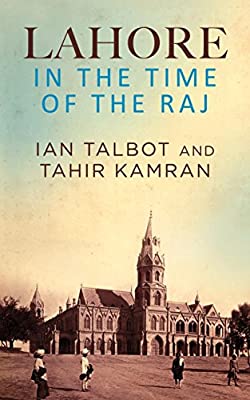Lahore in the Time of the Raj
|
|
The book contends that under British rule, the city of Lahore continued with its centuries old legacy of connection through trade, movements of people, and ideas beyond its boundaries.
Fully utilising modern means of communications such as the railways, steamships and print culture, the colonial Lahore ushered in a new age of globalisation that intensified its cultural, social, and commercial linkage with a wider world. This assertion stands in sharp opposition to the colonial representation of Lahore as “inward looking” and an isolated space fraught with squalor and disease. The book reveals that the city’s rich cultural, literary, and political heritage and their far reaching influence were cleverly brushed under the carpet because of the colonialists prefixed notions about Lahore’s interconnectedness and because “it took forms that did not form the focus of imperial gaze”. Colonial writings such as Through India with the Prince composed by a renowned journalist George Frederick Abbott lent a sinister air to the Walled City characterising it as an eerie “labyrinth of tortuous alleys” where tall wobbly houses were haphazardly stuffed together with shops and the entire atmosphere engulfed in a state of absolute stillness, “gloom and silence”. This extravagant description almost falls short of implying that even Ariadne’s thread would not suffice to find one’s way out of this stifling maze of passageways if one stepped inside the Walled City. The British therefore stayed away and created the need to build a new “modern” Lahore that would instantly distance the imperial masters from the “old” city on the one hand, and to heighten their status as enlightened and benevolent rulers of India on the other hand. The plain outside the Walled City was inscribed with new structures including the civil lines, the railway station, the High Court, Lawrence Garden, and the Government College; all representational of the civilising benefits of British power. The orientalist view of the inner city of Lahore as constricted and an enclosed entity is precisely what the book sets out to dispel and establish the region’s interconnectedness by bringing it centre stage on the cultural, social, educational, recreational, and political forum of North India. The book thus offers an important deviation from previous studies on colonial Lahore that have focused largely on its modernity, cosmopolitanism, and political history to the exclusion of Lahore’s position as “a space of globalised nodal connectivity” that transcended geographical specifity and reverberated its importance both “relationally” and internationally. The book is arranged into seven chapters each shaped by a specific theme whose core function is to show that Lahore was externally connected and not a bounded entity. Chapter 1, Colonial Lahore: The City Beyond, draws attention to the escalation pattern in migration to Lahore arising from new employment opportunities provided by the colonial rule. Lahore thus saw a massive influx of skilled artisans who participated in the construction of public buildings, the Civil Lines, the Cantonment and the railway workshops to name a few. Chapter 2, Darvarzas & Mohallas: Place & Space in Colonial Lahore, takes us on an insightful journey through the bazaars, neighbourhoods and alley-ways of the Walled City and unveils a world bustling with intellectual and political life that was shared by people coming from other parts of India including Calcutta, Bombay, and Delhi. The Bhati Gate locality, for example, was home to a number of literary giants whose influence spread all across North India. Under the wings of the Delhi emigrant Muhammad Hussain Azad, Lahore took on a new significance as a major Urdu cultural centre. Bhati Gate functioned as the originator of the Lahore cinema industry. It not only promoted local talent but also invited artists, musicians, and writers from the film studios in Calcutta and Bombay. Mochi Gate was popular for political connections and was notable for its role in advocating the demand for Pakistan in the 1940s. Chapter 3, Travellers, Tourists & Texts, alludes to imperial tourist guidebooks, an area previously neglected, and shows that by a remarkable sleight of advertisement the modernity of British rule was maintained by “emphasising the stereotype of a confined inner city.” Interestingly this view is counter pointed by bringing in another source, the travel account of the Webbs, which reveals that organisations like the Arya Samaj operating from the very heart of the walled city “radiated their influence throughout the subcontinent.” Chapter 4, Poets, Wrestlers & Cricketers: Patronage and Performance in Lahore and Beyond, is instructive in that it shows that the intellectual capacity of the city’s inhabitants was fully matched by their talent for sports such as the akhara (wrestling). Most importantly, the leading wrestlers held worldwide fame. The book illuminates that the mushairas (poetry contests), a highly popular pastime, championed the growth of nationalistic feelings in India. Chapter 5, A World of Goods: Consumption of Foreign Goods in Late Colonial Lahore, highlights that foreign products continuously trickled their way to local shelves. Chapter 6, Pilgrims and Shrines in the Colonial Age observes that Lahore’s importance as a railway hub for northwestern India facilitated Punjab pilgrims access Hijaz which soon became a nexus of political resistance against British rule. A comprehensive discussion of subversive elements is given in the final chapter, Martyrs, Migrants & Militants: Lahore’s Transnational Revolutionary Networks. The most compelling part of the debate is that it traces these revolutionary networks which stretched as far as Afghanistan, Arabia, Europe, and North America all the way back to Lahore. This indeed is further evidence of Lahore’s interconnectedness. The book asserts that the colonial portrayal of Lahore as a confined space is understandable as doing so was in line with the imperial political agenda. But for our own writers such as Syed Abdul Latif to not have attempted to evaluate the British narrative and to perpetuate it is quite disconcerting. It is crucial that in their attempt to revisit the history of the subcontinent our writers should assess the extent of knowledge of India that British display and expose its fallacy. The book wonderfully controls the indigenous narrative and spiritedly wrests Lahore from its stereotypical representation. The inner city provided a frame in which to exercise, encourage and foster the subcontinent’s intellectual capacity, sports acumen, educational and political endeavours. At the same time the book endorses that walled city’s cultural and social connections latched the region not only to “modern” Lahore but also to North India and beyond. Ayesha Rafiq | 7 July 2017 | Daily Times
|


